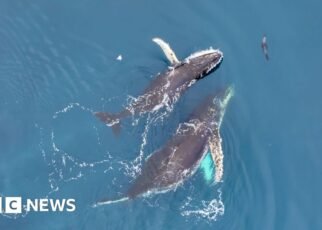[ad_1]
Footage of humpback whales captured by drones has revealed how the animals manoeuvre their whole bodies when they feed.
As BBC News filmed with scientists in the Antarctic Peninsula, one whale used its four-metre-long fin to sweep a net of bubbles around its prey and trap them, known as “bubble-netting”.
“The flick of that of that flipper really shows how adaptable, how creative, these animals can be,” said Dr Ari Friedlaender from the University of California Santa Cruz.
Humpbacks are “much more acrobatic” than other similarly sized whales, Dr Friedlaender said.
The wildlife charity WWF’s global whales expert, Chris Johnson, said the solo whale we watched “bubble-netting” was “using its fin as a tool” to trap krill, the tiny crustaceans that Antarctic whales eat more than one tonne of each day.
Humpback whales are the only species known to produce these solitary “bubble nets”.
The act can only be seen in detail from the air, so the use of drone cameras has revolutionised scientists’ ability to study it.
 Chris Johnson/WWF/UCSC/Research under NOAA permit
Chris Johnson/WWF/UCSC/Research under NOAA permitThe aerial view that drones provide has also shed light on the recovery of whale populations in parts of the world where they were hunted to the brink of extinction in the 20th Century.
An international team of researchers, including some from the British Antarctic Survey (BAS), has used drone cameras to study whales in South Georgia, a key location for the whaling industry in Antarctica.
BAS researcher Stephanie Martin shared with the BBC what she says is the first drone footage of a mother-calf pair of southern right whales off the coast of South Georgia.
“Seeing mother and calf pairs [here] is a strong indicator that these populations are slowly recovering,” she said.
She and her colleagues also filmed an Antarctic blue whale mother and calf – the biggest animals on Earth – feeding in the same area.
Before the 1930s, an estimated 40,000 blue whales were killed by whalers in South Georgia waters.
Ms Martin said it took until 2020 for researchers to find the giant mammals in those waters again. A survey that year recorded 58 sightings of adult blue whales there.
Shrinking whales
Scientists can also measure whales’ bodies using drones. There is evidence emerging that some of the animals are actually shrinking, which scientists have linked to climate change affecting their food supplies.
A study just published in the journal Global Change Biology revealed gray whales that feed in the shallow waters off the Pacific Northwest coast have shrunk significantly in the last two decades.
A gray whale born in 2020 is expected to reach an adult body length 1.65 metres (5ft 5in) shorter than a gray whale born before 2000.
The researchers say this could be an early warning that the population is starting to decline, or that it is not healthy.
“Size is critical for animals,” said Dr Enrico Pirotta from the University of St Andrews.
“It affects their behaviour, their physiology, and it has for the ecosystem they’re a part of.”
 Kevin C Bierlich
Kevin C BierlichAs well as helping researchers to monitor the emerging threats to whales, drones shine new light on some fascinating marine mammal behaviour.
By filming humpback whales working together to feed – something we witnessed in Antarctica – scientists gain insight into how the animals learn and co-operate.
“[When we’ve studied humpbacks] feeding in Alaska and off the US coast, the rules are very prescribed,” said Dr Friedlaender.
“There’s generally one animal blowing a bubble net around the prey and the other animals have these individual roles.
“In Antarctica, we often see multiple animals in a feeding ground all blowing bubbles at the same time.”
Researchers are still working to understand what this means, but some suspect that the Antarctic whales might still be learning the feeding technique and have not yet “refined it” to give each animal a role.
 Chris Johnson/WWF/UCSC/Research under NOAA permit
Chris Johnson/WWF/UCSC/Research under NOAA permitAsked if behaviour that we witnessed – humpbacks spinning, circling our boat and even interacting with other species – could be described as “play”, Dr Friedlaender said yes.
“They have the opportunity to be curious and interact with new objects or to interact with each other,” he said.
“It strengthens social bonds and I think that’s an absolutely critical thing for them.”
 Ari Friedlaender/UCSC/NMFS Permit 14809, ACA and UCSC IACUC permits
Ari Friedlaender/UCSC/NMFS Permit 14809, ACA and UCSC IACUC permits
[ad_2]
Source link




